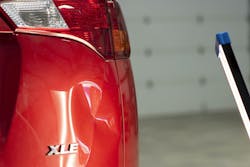Glue pull repair (GPR) is a method of auto body repair that gets the job done faster, more efficiently, and with less effort. The results are better than traditional methods and yield ways your shop can develop and retain more customers and earn greater profits.
A key ingredient to successful GPR is the lighting. Superior lighting allows technicians to clearly see the areas needing repairs, and accurately correct damage without causing further harm to the panel or its finishes.
Clear Coat, Traditional Repairs, and GPR
Traditional stud welding versus GPR is no contest. GPR does not penetrate the metal so there is no need to fill, sand, and finish holes. Instead of stud welding, the technician uses removable glue to attach a “tab” to the dented area, then pulls the dent out. Significantly, with GPR, you retain the OEM finish coat on the vehicle.
On the other hand, when you install a weld-on stud, you’re most likely asking for trouble. After the pull, you have to remove the stud and work the surface, which sometimes involves filling and can lead to inadvertently pulling the stud out completely, especially with ultra-thin and aluminum panels.
With GPR, you eliminate most of this. Plus, not only does the finish coat remain, but the clear coat stays, as well. If there is any damage to the finish or clear coat, it is extremely minor and easy to repair.
Good Lighting and the GPR Process
The initial step in repairing a dent is assessing the damage. Good lighting is essential. Using a professional GPR light, the tech views the panel, revealing the subtleties of the dent. This allows him to define clearly the area he will repair, make an initial assessment, and begin to develop an approach to the task.
GPR necessitates placing the tab correctly. The objective is to locate the tab in the center of the dent; placing it on a crown or high spot can cause even more damage. With good lighting, technicians can see the crowns and the lows around the damage and therefore can more easily determine the exact center of the dent.
After the Pull
Good lighting is important after the pull, too. Because the OEM finish remains, the technician can see if any “shoulders” have occurred in the metal after pulling the dent and removing the tab. These are small elevations in the metal around the primary area of the dent that residual pressure in the metal sometimes causes, creating slight bumps and knuckles. With superior lighting, you can see shoulders and high spots to easily knock them back down.
Important for Estimators
Effective lighting is valuable for estimators, too. A good reflection up from the panel allows them to take accurate photos and measurements to include with the information they provide to insurance companies. An exact determination of the extent of damage saves time and effort for everyone involved in the repair: the estimator, the shop owner, manager, technician, and ultimately the customer.
KECO Shop Lighting
Most shops do not have quality lighting, or they rely on shop lights for seeing and working with dents and repairs. Shop lights from KECO are specifically designed to provide the type of light and light blends for clearly seeing areas on a car or truck that require repair.
The premium 36x8 inch, 12-volt, four LED shop light and stand is lightweight and durable, providing maximum light and visibility for car and truck collision repair, body restoration, and detailing. The four LED strips in a warm-cool-warm-cool setup provide three light configurations to help in a variety of work environments. The single-stage, vertical adjustment, extendable boom arm finds hard-to-reach angles. Non-mark endcaps protect finishes and body paint. The locking swivel castor with integrated battery tray allows for easy mobility between bays and around other areas of the shop.
New Level 2 Collision Manager Kit
This kit, developed especially for the body shop, is ideal for Level 2 work, which covers smaller and/or more complex dents and involves tools and techniques to take the repair to a more finished state, using even less filler (if any at all), and preserving more OEM finishes. Level 2 includes aluminum panel repairs and advanced lighting techniques.
Other Lights
We also carry other industry-compatible choices. These cool/warm lights use LEDs, which provide a bright, steady light so technicians can more distinctly see imperfections in the panel. Battery power makes these lights portable and easy to move around jobs—no chords to battle.
Order today from KECO and find out for yourself what a difference professional lighting makes in your shop’s repair efforts. For 5 percent off of your next order, enter the promo code: FENDERBENDER5 at checkout. Orders placed before 2 p.m. ship the same day and collision kits all come with free shipping.
Learn more about GRP at www.kecotabs.com.
About the Author
Sponsored Content
The views and opinions expressed in this piece do not necessarily reflect those of 10 Missions Media and its associated brands.
